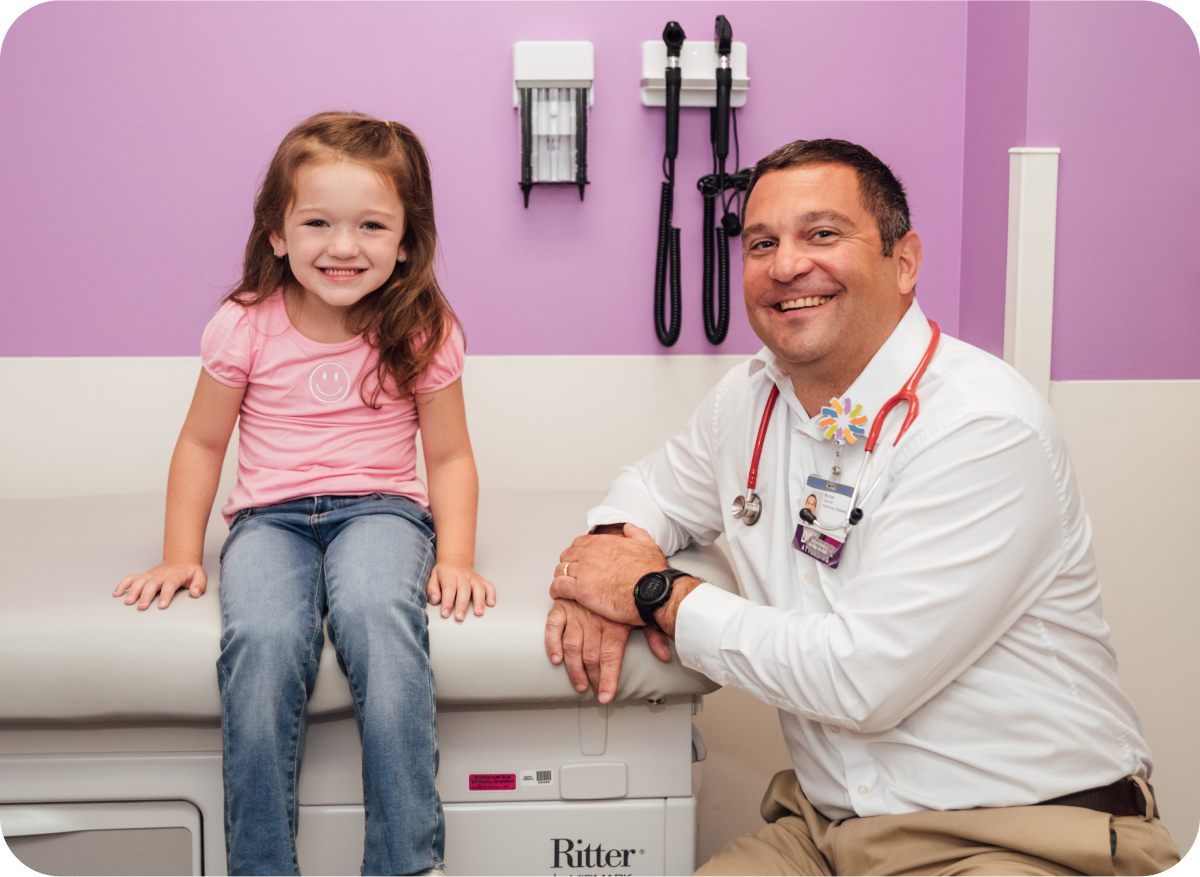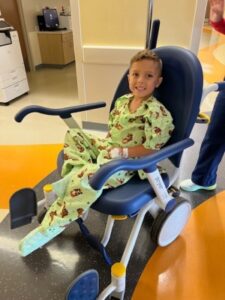Harper Gould

a complex case of gastroschisis
- patient name: Harper Gould
- patient age: 3
- condition: complex gastroschisis with jejunal and colonic atresia and congenital microcolon
- seen in: pediatric surgery
- providers: Oliver Soldes, MD, FACS, FAAP
In the late summer of 2020, Harper Gould was born during an emergency c-section five weeks early when the doctors discovered that her heart rate was undetectable.
When she was born, Harper was diagnosed with gastroschisis. Gastroschisis happens when the abdominal wall does not close during fetal life, and the abdominal organs are outside at birth. In complex cases, like Harper’s, there may also be volvulus with atresia (a twist in the intestine) and there may be a significant loss of bowel length and intestinal discontinuity, causing a short gut syndrome and obstruction. She was officially diagnosed with complex gastroschisis with jejunal and colonic atresia and congenital microcolon.
Treatment for gastroschisis begins as soon as possible after birth. Harper was transferred to the newborn intensive care unit (NICU) at Dayton Children’s Hospital. The most urgent priority was to reduce the intestines into the abdomen and close the abdominal wall over them. After her intestines were reduced into the abdomen with a silo bag, Oliver Soldes, MD, FACS, FAAP, pediatric surgeon, closed the abdominal wall and performed a multi-stage intestinal reconstruction.

multiple surgeries make for big improvements
After the successful closure of the abdominal wall, Harper had signs of intestinal obstruction due to jejunal and colonic atresia. She was unable to pass a bowel movement and every time her mom, Jessica, tried to feed her, she would throw up. Over the course of the next year, Harper had a series of surgeries to repair multiple intestinal atresia and reconstruct her intestines.
Dr. Soldes took Harper back to the operating room to perform an exploratory laparotomy to examine her intestines and repair them. During the laparotomy, Dr. Soldes discovered a segment of small bowel atresia and colonic atresia and identified an additional segment of injured and non-viable small intestine. The two areas of small intestine were repaired and a Mikulicz side-to-side colostomy was performed. This is a special type of colostomy that is done when the bowel is so small that the downstream bowel will be obstructed. It allows most of the stool to pass outside of the body while allowing some to pass downstream to stimulate growth of the downstream microcolon. The colostomy drains into a pouch attached to the abdomen.
After this surgery, numerous attempts to feed Harper were made. Unfortunately, she couldn’t get past one milliliter (about 0.03 oz) without throwing it back up along with bile. She had chronic partial bowel obstruction related to intestinal dysmotility and intestinal adhesions. Dysmotility (poor intestinal contraction) is common in patients with in-utero intestinal obstruction and gastroschisis.
A third surgery was needed. Dr. Soldes performed another exploratory laparotomy to relieve the obstruction, place a gastrostomy (g-tube) and Broviac catheter for IV nutrition. He removed multiple intestinal adhesions, closed Harper’s colostomy and created an upstream Mikulicz side-to-side ileostomy.
Finally, with the ileostomy, Harper was able to have bowel movements and eat without throwing up. With her new ileostomy, g-tube and Broviac line, Harper was discharged from the hospital right before Christmas, and she was doing great!
In May 2021, Harper returned to Dayton Children’s for her fourth surgery where Dr. Soldes closed her ileostomy. Three days after surgery, Harper had her first real bowel movement without the assistance of a colostomy or ileostomy. A week later, she was discharged from the hospital and went home.
Over the course of the next few months, Harper was doing well and gaining weight. She was taking all her nutrition by mouth and no longer needed IV nutrition. This milestone allowed Harper to go in for her fifth surgery to have the Broviac line removed, leaving her with just the g-tube.
Shortly after Harper’s first birthday, she returned to Dayton Children’s for her sixth and final surgery with Dr. Soldes to have her g-tube removed and to close the opening where it was placed.
exceeding expectations
It has been nearly two years since Harper’s last surgery and she is doing amazing and exceeding all expectations, according to Jessica.
“just be patient. It all seems like it’s never going to end but these kinds of complex cases just take time. When you look back on it, you just become so appreciative of everyone who was involved in your child’s case.” – Jessica Teegarden, Harper’s mom
share your story
Every patient journey at Dayton Children’s is powerful — from NICU miracles to courageous cancer survivors and beyond. These patient stories not only celebrate our families but also offer hope and encouragement to others facing similar challenges. Share your experience today and help inspire, support, and celebrate the strength of our patients and families.

care that goes above and beyond
Because every child deserves care that goes above and beyond, Dayton Children’s provides compassionate, expert care for kids of all ages. Find a provider, schedule an appointment, or learn more about conditions we treat today.




